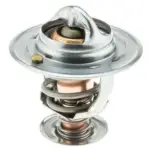The EGR Valve stands for Exhaust Gas Recirculation. It is a very crucial component to the engine’s health and performance located in the intake manifold. The purpose of the EGR valve is to reduce emissions be routing exhaust gases back into the combustion chambers of the engine. In order to understand the symptoms of a bad EGR valve, you must first know how it works and what it does.

What an EGR Valve Does
Engines produce greenhouse gases. When engines run at high temperatures, green house gases like nitrous oxide can be produced. The EGR valve routes exhaust gases back into the intake which eventually make it to the combustion chamber. This dilutes the air fuel mixture going into the combustion chamber and reduces the combustion temperature in the engine. Reducing combustion chamber temperature helps to lower the amount of nitrous oxide produced.
The EGR valve routes exhaust gases back into the intake which eventually make it to the combustion chamber.
Higher combustion temperatures increase the risk of detonation (pinging). Detonation is when the fuel in the combustion chamber is ignited in an isolated pocket apart from the rest of the envelope of combustion. Detonation will cause stress on valves, pistons, and turbochargers.The EGR valve also lowers an engines octane requirement.
When the Valve is Open or Closed
An EGR valve connects the exhaust manifold to the intake valve similar to a PCV valve. Exhaust gases are not combustible due to the lack of sufficient oxygen. However recirculating these exhaust gases back into the intake manifold dilutes the oxygen fuel mixture entering the engine. The diluted mixture reduces the combustibility of the mixture and it reduces combustion temperatures.
The EGR Valve is controlled by the PCM (Power-train control module). The valve is normally closed during startup, when the engine is cold, idle, and high engine load or acceleration. Under a steady load, usually when the vehicle is cruising, the EGR valve is open. The valve should only be open when your engine is at operating temperature.
How EGR Valves Work
There are two different ways EGR valves work, some are vacuum operated, while others are electronically controlled with a stepper motor. Vacuum operated EGR valves are generally seen on older vehicles. They are completely mechanical and do not utilize electronic sensors like newer electronically controlled valves.
Vacuum Operated EGR Valve – The EGR valve has a vacuum (suction) line to the air intake. As the air in the intake rushes into the cylinder it creates a suction force on the closed EGR valve and pulls the valve seat open. Exhaust gases also force open the valve by pushing on it from the other side. Exhaust gases then flow back into the intake diluting air/fuel mixture. As the air intake vacuum force is reduced, the return spring will close the EGR valve.
Electronically Operated EGR Valve – Due to increasing emission standards electronically operated valves have become more common. This is because these valves can precisely monitor the engine’s temperature and needs providing greater efficiency. EGR valves use solenoids and electronic motors to control the valve opening. Solenoid controlled valves will still have a return spring since the solenoid can only move the valve in one direction. All electronically operated valves include a position sensor to tell the electronic control module (ECM) the valves position. The ECM will gather data from all of its sensors and determine the position that the EGR valve should open to. The ECM decides the position of the EGR valve based on information from the mass air flow sensor, throttle position sensor, manifold absolute pressure sensor, and idle air sensor.
Symptoms of a Bad EGR Valve
Rough Idle – If you experience rough idle after the engine is warmed up, you could have a stuck open EGR valve. An open EGR valve will continuously bypass exhaust gases to the intake manifold diluting the fuel mixture. You may also notice lower engine speeds than normal
Poor Performance – EGR valve could be stuck, wide open, or somewhere in-between. You will most likely notice reduced acceleration and even erratic engine behavior. With a stuck open valve, reduced fuel economy can also occur. This is because the EGR valve is lowering the combustion temperature and the engine is not running at its proper operating temperature. The lower operating temperature reduces efficiency.
Engine Stall – This is closely related to rough idling but more severe. Engine stalls can be caused by stuck open EGR valves. In some cases the EGR valve can dilute the air/fuel mixture going into the intake to the point where the vehicle will stall.
Increased Emissions – Increased emissions can be caused by either an open or closed EGR valve. If the valve is opened, the combustion temperature will be lower reducing efficiency. The reduced temperature causes more fuel to pass through unburnt. This unburnt fuel is then released as hydrocarbon gases out of the exhaust. A closed valve causes excessive combustion temperatures. These high temperatures encourage the formation of nitrous oxide
Engine Knocking – Other symptoms of bad EGR valve are engine knocking. A closed valve increases the temperature in the combustion temperature. This increased temperature can cause detonation. This problem typically occurs at low rpm. If you experience engine knocking have your vehicle checked out immediately.
What if you have a bad EGR Valve?
Many of these symptoms can also caused by other components on the engine. These components include, spark plugs, fuel pump, or engine sensors. The ECM utilizes many different sensors to control the EGR valve. In some cases on of these sensors could be malfunctioning and giving the ECM bad data. If you are comfortable working on your vehicle yourself there are some things you can check.
Investigate your engine’s intake system for leaks. Also check on your engine air filter. If it has been a long time since it was last cleaned or replaced, consider replacing it. If you have a vacuum operated EGR valve, check all of your vacuum line and hoses for leaks. A lose of vacuum pressure and the EGR valve might not be able to open.
In many cases, the issue can be internal to the EGR valve. It could be due to carbon buildup on the valve or even an internal electrical fault. Having your vehicle inspected by qualified mechanics is usually the best option.



